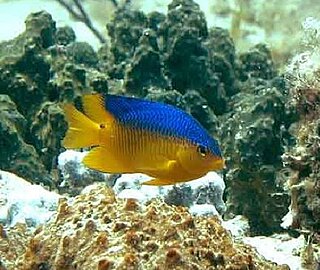
Pomacentridae is a family of ray-finned fish, comprising the damselfishes and clownfishes. This family were formerly placed in the order Perciformes but are now regarded as being incertae sedis in the subseries Ovalentaria in the clade Percomorpha. They are primarily marine, while a few species inhabit freshwater and brackish environments. They are noted for their hardy constitutions and territoriality. Many are brightly colored, so they are popular in aquaria.

Corymbia calophylla, commonly known as marri, is a species of flowering plant in the family Myrtaceae and is endemic to the southwest of Western Australia. It is a tree or mallee with rough bark on part or all of the trunk, lance-shaped adult leaves, branched clusters of cup-shaped or pear-shaped flower buds, each branch with three or seven buds, white to pink flowers, and relatively large oval to urn-shaped fruit, colloquially known as honky nuts. Marri wood has had many uses, both for Aboriginal people, and in the construction industry.

The tasselled wobbegong is a species of carpet shark in the family Orectolobidae and the only member of the genus Eucrossorhinus. It inhabits shallow coral reefs off northern Australia, New Guinea, and adjacent islands. Reaching 1.8 m (5.9 ft) in length, this species has a broad and flattened body and head. Its most distinctive trait is a fringe of branching dermal flaps around its head, which extends onto its chin. The fringe, along with its complex color pattern of small blotches and reticulations, enable it to camouflage itself against the reef environment.

Angophora costata, commonly known as Sydney red gum, rusty gum or smooth-barked apple, is a species of tree that is endemic to eastern Australia. Reaching 30 m (100 ft) in height, the species has distinctive smooth bark that is pinkish or orange-brown when new and fades to grey with age. Its lance-shaped leaves are arranged in opposite pairs along the stems, with white or creamy white flowers appearing from October to December. The flower buds are usually arranged in groups of three, followed by ribbed, oval or bell-shaped fruit.

Melo amphora, common name the Diadem volute, is a very large sea snail, a marine gastropod mollusc in the family Volutidae, the volutes.
Pteronisis is a genus of coral in the family Mopseidae. The name derives from Greek pteron, meaning "feather", in allusion to the pinnate branching.

Orectolobus reticulatus, the network wobbegong, is a recently described species of carpet shark found in relatively shallow waters off Kimberley and Darwin in north-western Australia. With a known maximum length of only 52.3 centimetres (20.6 in), it may be the smallest species of wobbegong. Until its description in 2008, it had been confused with the northern wobbegong. The network wobbegong has a short snout, broad head, elongated body, and two dorsal fins, with the first being slightly larger than the second. Its body is grayish brown with darker brown markings and a pale yellow underbelly. The network wobbegong lives in shallow waters along reefy bottoms.

Gleichenia dicarpa, commonly known as pouched coral fern or tangle fern, is a small fern of the family Gleicheniaceae found in eastern Australia, New Caledonia and New Zealand. It forms tangled thickets in wet places such as swamps and riverbanks.
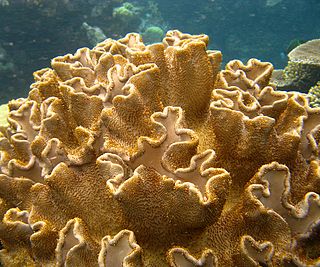
Alcyoniidae is a family of leathery or soft corals in the phylum Cnidaria.
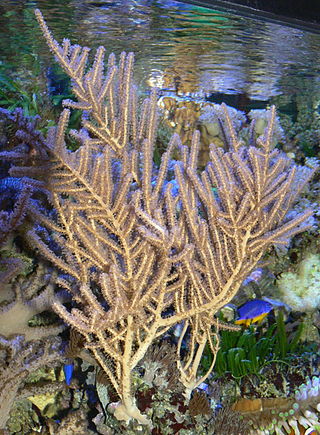
Gorgoniidae is a family of soft corals, a member of the subclass Octocorallia in the phylum Cnidaria. Nearly all the genera and species are native to the east and west coasts of America.

Acropora secale is a species of branching staghorn stony coral. It is found in shallow parts of the Indo-Pacific Ocean and the type locality is Sri Lanka. The oldest fossils found date back to the Pleistocene.
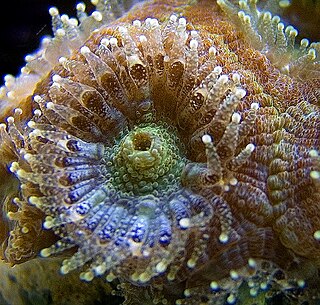
Micromussa lordhowensis, previously known as the Acan Lord, is a species of stony coral in the family Lobophylliidae. It is a widespread and common coral with large polyps occurring on shallow reefs in the Indo-Pacific Ocean. It was originally classified under the genus Acanthastrea, and reclassified under the genus Micromussa in 2016.

Pocillopora verrucosa, commonly known as cauliflower coral, rasp coral, or knob-horned coral, is a species of stony coral in the family Pocilloporidae. It is native to tropical and subtropical parts of the Indian and Pacific Oceans.
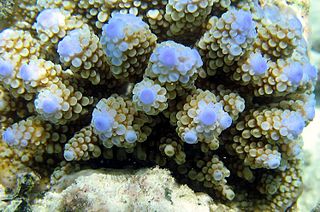
Acropora nasuta is a species of branching stony coral in the family Acroporidae. It is native to the western and central Indo-Pacific where it is found in shallow reef habitats. Like other corals of the genus Acropora, it is susceptible to coral bleaching and coral diseases and the IUCN has listed it as being "Near Threatened".
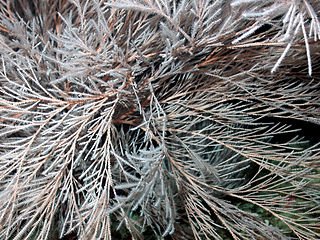
Aphanipathes is a diverse genus of black corals in the family Aphanipathidae, typified by large polypar spines. However, there are some disagreement in the correct taxonomic classification of this genus. The Global Biodiversity Information Facility (GBIF) classifies Aphanipathes as being a genus of the family Aphanipathidae while the Integrated Taxonomic Information System (ITIS) classifies it as a genus of the family Antipathidae.
Acropora kimbeensis is a species of acroporid coral that was first described by Dr. Carden Wallace in 1999. Found in marine, tropical, shallow reefs usually at depths of 3 to 12 m, but can occur as low as 15 m (49 ft). It is listed as a vulnerable species on the IUCN Red List, and it is thought to have a decreasing population. It is not common and found over a large area, and is listed on CITES Appendix II.
Acropora papillare is a species of acroporid coral that was first described by Latypov in 1992. Found in marine, tropical, shallow reefs in areas exposed to waves, it occurs at depths of between 1 and 5 m. It is classed as a vulnerable species on the IUCN Red List, and it has a decreasing population. It is uncommon but found over a large area, including in three regions of Indonesia, and is classified under CITES Appendix II.
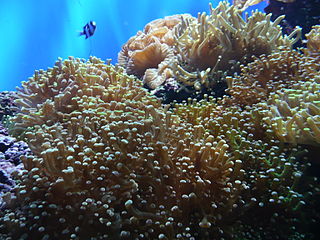
Euphylliidae are known as a family of polyped stony corals under the order Scleractinia.
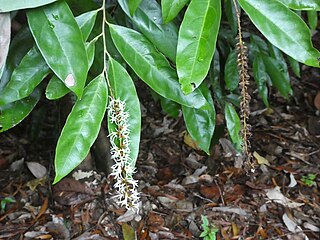
Neostrearia is a monotypic genus - i.e. a genus containing only one species - of plants in the witch-hazel family Hamamelidaceae. It is the second described of three monotypic Australian genera in this family, the others being Ostrearia and Noahdendron. It is most closely related to these genera, as well as Trichocladus from southern Africa and Dicoryphe from Madagascar, and together these five genera form a distinct clade within Hamamelidaceae.

Myristica insipida, commonly known in Australia as Australian nutmeg, Queensland nutmeg or native nutmeg, is a small rainforest tree in the family Myristicaceae native to parts of Malesia, Papuasia and Australia. It is closely related to the commercially-important species of nutmeg, M. fragrans.

















